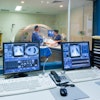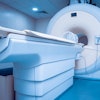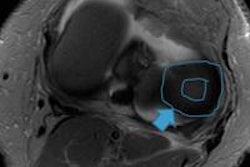With 3-tesla MR images to help determine the appropriate surgical technique, patients who undergo longitudinal meniscus repairs can return to a high level of function at long-term follow-up, according to a study presented last week at the American Orthopaedic Society for Sports Medicine's (AOSSM) annual meeting in Providence, RI.
The 10-year prospective study of single longitudinal meniscus repairs in the central third avascular region used 3-tesla MRI cartilage-sensitive pulse sequences, including T2 mapping, to define meniscus function. Preservation of the meniscus is paramount for long-term knee joint function.
"It has long been established that peripheral mensical tears are repaired and do well, but there is no well-established algorithm for tears, and the long-term outcome is still unknown," said study co-author Hollis Potter, MD, from the Hospital for Special Surgery in New York City. "We do know that near-total meniscectomy leads to poor joint function. MRI is helpful in giving you some sense of cartilage biology that we can't glean from radiographs alone."
The lead author of the study is Frank Noyes, MD, chairman and CEO of the Cincinnati Sports Medicine and Orthopaedic Center in Ohio, where the study was conducted.
Patient enrollment
The study enrolled 31 patients (17 males and 14 females) with a mean age of approximately 17 years and a total of 33 knee repairs. Most of the patients had undergone anterior cruciate ligament (ACL) reconstruction, with a mix of acute and chronic conditions.
A subset of 16 patients who underwent 17 meniscus repairs before the age of 20 received long-term follow-up. All but one patent had concomitant ACL reconstruction. The researchers conducted 3-tesla MRI evaluations on 12 lateral and five medial menisci between 12 and 22 years postoperatively.
Patients also received a comprehensive clinical evaluation and weight-bearing radiographs, while rehabilitation included an immediate range of motion from 0° to 90°.
Normal activity
Upon follow-up after surgery, the researchers found that all of the patients were asymptomatic for tibiofemoral joint line pain and were participating in a variety of athletic activities with no problems and no symptoms with daily or work activities.
"Meniscal repair success was not affected by ACL reconstruction," Potter said. "These patients had all their stability restored."
The 3-tesla MR images showed retention of the coronal and sagittal position of the menisci without extrusion in 13 knees and with slight extrusion in four knees. A displaced meniscus tear that extended onto both surfaces also was noted in four knees.
The researchers noted that using 3-tesla MRI, radiographs, and clinical parameters resulted in a "reasonable success rate" among the patients, "suggestive of long-term meniscus function."
In reference to previous research, Potter said that many studies did not use both MRI and weight-bearing radiographs in evaluating meniscus repair. "MRI is helpful in giving you some sense of cartilage biology that we can't glean from radiographs alone," she added.
By Wayne Forrest
AuntMinnie.com staff writer
July 23, 2010
Related Reading
MRI can identify osteoarthritis risk factors 10 years early, June 30, 2010
Software saves time by segmenting meniscus in knee MR images, February 1, 2010
Sodium MRI at 3 tesla detects early signs of osteoarthritis, February 5, 2009
U.K. study finds direct access to knee MRI is cost-effective, April 3, 2008
AAOS study: MRI overused for knee osteoarthritis, March 6, 2008
Copyright © 2010 AuntMinnie.com


.fFmgij6Hin.png?auto=compress%2Cformat&fit=crop&h=100&q=70&w=100)





.fFmgij6Hin.png?auto=compress%2Cformat&fit=crop&h=167&q=70&w=250)











